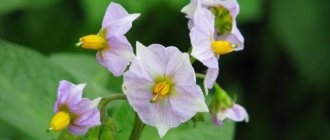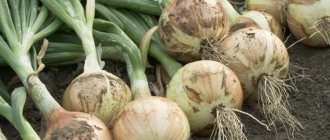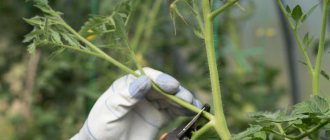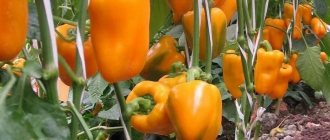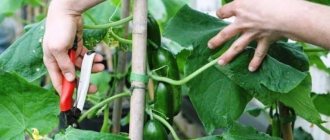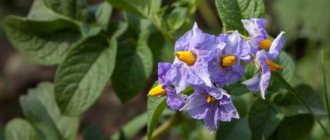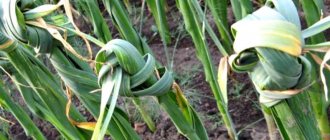Many farmers mow down the tops of their potatoes. Some do this to increase yield, others to fight diseases. In any case, it is important to carry out the procedure correctly and use the resulting waste wisely. Timely cutting of the tops contributes to the accumulation of starch, thickening the peel and improving the taste of the tubers. Green mass is used in the garden as a source of nutrients and material for mulching fruit and berry trees. Let's take a closer look at when to mow potato tops and why.
Why do they trim the tops of potatoes?
There are several reasons for removing potato tops:
- tubers ripen faster and receive more nutrients;
- drying of soil between rows is accelerated;
- potato skins become rough;
- the risk of late blight infection is minimized.
If the tops are not cut, it is convenient to determine the degree of maturity of the potatoes by using them: before harvesting, summer residents make sure that the green mass has completely withered.
How to trim the tops correctly
Compliance with the recommendations during the procedure will have a positive effect on the quality of the crop.
How to remove potato tops:
- Cut the tops with a sharp garden knife or scythe.
- The height of the basal stem remaining after pruning should not exceed 15 cm.
- The procedure is divided into 2 stages: 3 weeks before harvesting, the tops are removed, a week later the stems are shortened.
- The cut grass is dried and used as fertilizer.
- Diseased leaves and stems are burned.
When deciding to trim the stems, it is important to consider the purpose of further use of the potatoes.
When consuming young tubers, mowing the tops is not required. The tubers will grow with thin skin and low starch content. For long-term storage of vegetables, you will need to remove the tops. In this case, the tubers will form a thick skin and accumulate starch.
This is interesting:
Life hacks from experienced farmers: why pick flowers from potatoes and what does it give?
Reasons for tops drying out and whether potatoes grow after this
Pruning rules
Compliance with basic rules during the process of removing tops will help to avoid difficulties during harvesting root crops.
- The top part of the bushes is cut off with sharp garden tools or mowed.
- To harvest potatoes manually, leave root shoots no more than 15 centimeters long. In this case, when harvesting, it will be easier to detect and pull root crops out of the ground.
- For mechanized harvesting of vegetables, plants are pruned at the root.
- Cutting bushes on private plots or vegetable gardens takes place in 2 stages. First, the tops of the plants are cut off, and only after 5-7 days are the stems trimmed.
- If the plants are dead and there is no way to use garden tools, it is recommended to break the bushes.
- You can also break the bushes if there has been heavy rain and the plants have leaned heavily towards the ground.
After completion of the work, the cut bushes are removed from the garden plot to avoid the development of diseases or pest attacks. Harvesting after the tops cutting procedure begins no earlier than 10-15 days later. During this time, the tubers will accumulate useful substances, and the protective peel will strengthen.
See also Description, characteristics and nuances of growing Rosara potatoes
When to trim the tops
At the stage of bud formation and during the flowering period, potatoes are fed with complex fertilizer “Aquarin” (10 g of the drug is diluted in 10 liters of water) or nettle infusion. This will allow the plants to accumulate nutrients, which, after removing the tops, will feed the tubers.
Nettle infusion is prepared a month before planned use.
Instructions:
- 1 kg of nettle leaves and stems are crushed.
- The resulting raw materials are placed in a bucket and 10 liters of water are poured.
- The bucket is covered with a lid, the mixture is left to ferment for 30 days.
- The infused composition is filtered through a sieve.
- Before use, the infusion is diluted with water in a ratio of 1:10.
Step-by-step scheme for processing potatoes:
- Before starting work, dilute the fertilizer according to the instructions.
- Pour the resulting mixture into the sprayer.
- In the morning or evening in dry, windless weather, treat the bushes: spray the leaves and stems on all sides.
- Repeat the procedure after 14 days.
It is optimal to trim the tops 30 days after flowering ends. The main prerequisite for starting the procedure is stems that have turned yellow by more than 50%.
The exact timing of pruning is determined by the potato variety and weather conditions. Early varieties ripen in the second half of August, late ones in mid-September. For the latter, pruning is carried out at least 21 days before the first frost.
Reference. If the purpose of growing bushes is to obtain seed tubers, the tops are cut off 3 weeks after flowering has completed.
When affected by late blight, the tops are cut off immediately. This will prevent the infection from spreading to the tubers and soil.
When to cut off potato tops?...
Mowing when leaves are damaged
Late blight disease of leaves and stems allows you to deviate from the rules and timing of pruning. The harvest is saved immediately when:
- leaf damage;
- cold nights, morning fogs and dew.
Late blight on potatoes comes from the soil in which the mycelium with spores lives. With alternating drizzling rains and scorching sun, along with cool nights and morning dew, late blight actively develops.
Signs of the disease:
- dark brown spots on the foliage, rapidly increasing in size;
- gray coating on affected leaves;
- blackening of green mass, drying of stems.
Harvested tops with signs of disease are removed from the site and burned.
Why do you mow potato tops?
Trimming potato tops is multifunctional. If pruning is done on time, there will be no harm to the plant, and the benefits are obvious. When growing a crop for commercial purposes to sell tubers of technical ripeness, pruning is part of agricultural technology. After removing the green mass, the young root crop forms a peel faster. A denser top part will increase the shelf life of the vegetable.
Why do you need to trim stems:
- The plant stops distributing nutrients between the upper and lower parts, the fruits develop faster, accumulate enough dry matter, which determines the degree of nutritional value of the crop.
- Pruning the vegetative mass promotes the simultaneous ripening of tubers; in one area, a different state of the plant bushes is noted: on some the tops have turned yellow and died, on others they are still green.
- Timely pruning promotes rapid formation of the peel, it becomes denser. Root crops tolerate transportation well, are less likely to be subject to mechanical damage during harvesting, and their shelf life is significantly increased.
- If the weather is warm, dry, even a short period of rain can trigger regrowth of the top of the bush, especially in late summer when the tubers ripen. The reverse of the natural process is observed - the stems receive nutrition not only from the roots, but also pull some from the tubers. In this case, pruning is necessary.
- Pruning the plant will make harvesting easier; the stems will not interfere, this is especially true during mechanized work.
Another important reason is late blight. Fungal infection appears during the flowering period. The first lesion is noted on the upper part of the plant, then the infection spreads to the stems and tubers. Diseased root vegetables are unsuitable for consumption. Fungal spores from the top of the bush pass into the soil; low temperatures are not a problem for them; they overwinter safely.
Important! The infected area cannot be used for planting next season.
Pruning leaves and stems is necessary to reduce the Colorado potato beetle population. The larvae feed on the green part of the plant. Lack of food reduces the number of pests.
Do potatoes grow after mowing the tops?
Removing green mass entails stopping the growth of tubers.
At the same time, a number of useful accompanying processes are noted:
- vegetables accumulate nutrients;
- the peel begins to harden;
- the soil between the rows dries out.
If you mow the tops, will potatoes grow? Although the tubers will stop growing, they will be saturated with nutrients, and their shelf life will increase during long-term storage.
Reasons for intensive growth of tops
A large green mass of potatoes is characteristic of varieties with a low starch content. In other cases, it indicates an imbalance.
Timely identification of the cause of active growth of tops and taking preventive measures will save the harvest.
Excess nitrogen
This is the most common cause of top growth. Excess nitrogen is formed from the use of mullein, humus, bird droppings, and compost in the spring and autumn as fertilizers.
Large tubers
The tops can grow if the planting material is chosen incorrectly. Tubers the size of a chicken egg are considered optimal. Large potatoes for planting will bring large tops, not a rich harvest.
Interesting! In large areas it is convenient to use a potato topper.
There are a lot of nutrients in large seed material. This allows the stems and foliage to feed from the mother tuber for a long time, slowing down the growth of roots and stolons.
Lack of light
Shade and partial shade lead to increased growth of green mass. With a lack of light, the plant stretches out in search of it, the stems become thin, the leaves become small.
Another reason for the lack of light is dense plantings of tubers. In pursuit of high yields, farmers plant seeds close together. The effect is the opposite: the tubers become smaller, the stems stretch.
Weather
The optimal conditions for growing potatoes are warm, sunny weather at +22…+26°C. If such a temperature is accompanied by a lot of rain, intensive growth of tops cannot be avoided.
Why do you need tops?
The tops serve as a source of nutrients for the tuber. Thanks to the photosynthesis it carries out, the tops allow the tubers to germinate better and gain weight. If the root system uses soil resources to provide the tuber with a supply of all the necessary substances, then the tops use light, converting its energy into the energy of chemical bonds. Simply put, the tops take a vital part in the formation of tasty and juicy potatoes, from which we subsequently prepare many mouth-watering dishes.
The tops feed the tubers until the budding period
The tops appear immediately after budding and mark the onset of flowering. At this moment, there is no talk of any tubers yet, and the main task of the gardener is to loosen the soil to evenly distribute the fertilizer ingredients.
The condition of the tops can say a lot about the future harvest. If it is thick and strong, then most likely there are good and equally large ripening tubers underneath. In turn, it makes no sense to expect a rich harvest from drying yellow tops. Frail sprouts will not be able to nourish the fruits with all the necessary substances.
Nitrogen fertilizers contribute to thickening of the tops, which is undesirable for tubers
When fertilizing potatoes, the gardener should be careful and select the right components, since not all ingredients have a positive effect on the tubers. For example, nitrogen fertilizers perfectly fertilize the soil, but promote the development of tops, ignoring the root system of the potato. As a result, the harvest will be more than meager. Even removing the tops will not help the potatoes gain strength.
What to do if the tops are high
If tall tops are not typical for a variety, this is a reason to worry.
Prevention measures:
- Excess nitrogen is removed by reducing nitrogen fertilizing (compost, humus, etc.) and increasing phosphorus. A superphosphate solution is well suited (100 g of the drug is diluted in 10 liters of water). The prepared mixture is generously sprayed onto the bushes in the morning or evening in dry weather.
- With the lack of lighting, the problem will be solved for the next season. It is recommended to reconsider the planting location, optimally sunny location.
The tops are low
Low tops are not a reason to worry if the characteristics of the variety do not suggest its growth. It’s another matter if the cause of the low green mass of potatoes is diseases.
Black scab (rhizoctoniosis) affects all parts of the plant. Black growths or depressed dark spots are visible on the tubers. In warm and humid weather, a whitish coating (dry rot) appears on the stems. The leaves curl at the top, and airy green tubers grow in the axils.
Preventive measures include calcining the seed material in the sun until a green tint appears and later planting in the ground. Treatment of infected bushes is determined by their growth phase. When the stems grow, the plants are watered with liquid mullein (500 g diluted in 10 liters of water, 0.5 liters are spent per bush). In the flowering phase 2 tbsp. Mullein is diluted in 10 liters of water, 0.5 liters of the composition are added to 1 plant.
Brown bacterial rot is manifested by wilting of leaves. The foliage turns greenish-bronze, then curls and falls off. The stems turn brown and rot at the base. When cut, the tubers have whitish rings. When pressed, they release viscous brown mucus.
Methods for destroying brown rot are ineffective. They fight the disease by completely renewing the seed material, timely weeding (every 2 weeks), and observing the rules of crop rotation. The best crop predecessors are cucumbers, cabbage, legumes, and pumpkins.
Fluoride deficiency is indicated by a purple ring on the cut of a young tuber. Replenish the lack of nutrients with superphosphate. To do this, dissolve 100 g of the drug in 1 liter of water, leave for a day, then add another 9 liters of water. The resulting solution is poured into a spray bottle and sprayed once in the morning or evening in dry weather.
Using cut tops
The removed green potato mass is used in garden plots as mulch, ash, and compost.
Important! For these purposes, take healthy tops, without signs of disease.
Mulching is carried out in late autumn. The trunk circles of fruit trees are covered with a layer of tops, 50–75 cm away from the trunk. For young plants, a mulch thickness of 5–6 cm is sufficient, for adults – 8–10 cm.
To prepare phosphorus-potassium fertilizer, the tops are burned in an iron barrel. After cooling, the resulting ash is collected in a dry container, covered with a lid and stored in a dry place.
Ash is added when digging up a site in spring or autumn (100–200 g per 1 m²) or 1 tbsp is added. l. into the holes before planting.
Compost is prepared in a box, trench or heap according to the following scheme:
- Choose a shady place, away from buildings.
- 20 cm of peat or leaves are poured onto the bottom, and 2-3 cm of soil on top.
- Next, 15–20 cm of tops are laid.
- Cover all 3 cm of soil mixed with ash. Add 2 tbsp to a bucket of soil. l. ash.
- The materials are alternated until the pile reaches 1.5 m in height.
- To speed up the process, each layer of soil is watered with 1 liter of slurry.
- Lay 5 cm of peat or soil on top.
- In dry weather, the pile is watered; during rains, it is covered with film.
- Compost ripening time is from 6 months to 2 years. Readiness is determined by the smell of earth and a loose brown mass.
Apply compost before planting: add it directly to the holes, 1 liter per hole, or during digging (1 bucket per 1 m²).
What to do with POTATOES and TOMATO HOPS in the fall?
Potato tops. Using potato tops for compost and other purposes
Harvesting potato tops begins 10-14 days before digging up the tubers. The tops are mowed and taken outside the site. Thanks to this, the tubers are not infected with late blight, the spores of which can be on the stem and get into the root system. In addition, mowing simplifies mechanical harvesting and speeds up the ripening of potatoes. The skin becomes hard, protecting the potatoes during transportation. There are several ways to recycle potato tops; they are valuable biological material.
1. Compost. Potato tops retain pathogenic fungi that cause dangerous diseases, such as late blight. To avoid infecting future plants, the tops placed in the compost pit are watered with a one percent solution of copper sulfate (2-3 tablespoons per bucket of water), after which the top is covered with a layer of earth and sawdust.
Compost with potato tops can be used no earlier than the third year after laying. This time is enough for the fungal spores to die.
The tops went to compost
2. Ash. It will be useful for potato growers who do not want to bother with compost. The tops are collected in one pile outside the garden, dried and burned. The remains are collected in a plastic bag or bucket.
Ash from tops is a valuable phosphorus-potassium fertilizer and contains other microelements useful for potatoes: iron, manganese, molybdenum, boron and others. The resulting ash is applied in the fall for plowing and cultivation.
Potato ash
3. Laying under fruit trees. Potato tops are laid in a thick layer in the tree trunks. This creates a natural shelter that protects the root system from frost in winter. In addition, the tops prevent weeds from growing and repel pests, and after rotting, fertilizer is obtained. Potatoes have no common diseases with apple trees, plums, and cherries.
4. Pest control hood. An affordable, environmentally friendly product. Potato leaves and stems contain high concentrations of solanine and other toxic compounds. Water extracts of tops help against all types of aphids, spider mites, cabbage whites, moths, flea beetles, cutworms and caterpillars on fruit trees. Toxic compounds in potatoes decompose without being absorbed into fruits and vegetables. The last treatment is done 10-14 days before harvest.
To prepare the infusion, you need fresh or dried tops that are not infected with fungus. Extracts cannot be made from diseased plants. The tops (600 grams fresh or 400 grams dried) are crushed, poured with 5 liters of water, covered with a lid, left for 4-5 hours in a warm place, then filtered.
Before pouring into the sprayer, add 50 grams of grated laundry soap to the infusion. This improves the solution's adhesion to the leaves and kills some insects. The finished poison is applied in the evening in dry weather every 3-10 days, depending on the number of pests.
Potato tops should not be fed to livestock (cows, horses, pigs), since solanine destroys the digestive system of animals. Some livestock breeders believe that young potato shoots can be given to sheep for rapid wool growth, but this hypothesis has not yet been scientifically proven.
